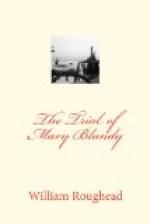On the receipt of Lord Mark’s letter, Mrs. Blandy, womanlike, believed the worst: “her poor Polly was ruined.” But her sympathies were so far enlisted on behalf of the fascinating intended that she eagerly clutched at any explanation, however lame, which would put things upon the old footing. She proved a powerful advocate; and, in the end, Mr. Blandy, accepting his guest’s word, allowed the engagement to continue in the meantime, until the result of the legal proceedings should be known. He was as loath to forego the chance of such an aristocratic connection as was his wife to part from so “genteel” a friend; while Mary Blandy—well, the damsels of her day were not morbidly nice in such matters, more than once had the nuptial cup eluded her expectant lips, enfin, she was nearing her thirtieth year: such an opportunity, as Mr. Bunthorne has it, might not occur again. With the proverbial blindness of those unwilling to see, the old man did nothing further in regard to Lord Mark Kerr’s communication; that nobleman, annoyed at the indifference with which his well-meant warning had been received, forbade his kinsman the house, and the Blandys were thus deprived of their only means of knowledge as to the doings of their ambiguous guest.
For the movements of that gentleman from this time until the first “date” in the case, August, 1750, we must rely mainly upon the narrative given by his fair fiancee in her Own Account, and, unfortunately, after the manner of her sex, she is somewhat careless of dates. This first visit of Cranstoun lasted “five or six months”—from the autumn of 1747 till the spring of 1748—when he went to London on the footing that Mary, with her father’s permission, should “stay for him” till the “unhappy affair” with his soi-disant spouse was legally determined. Pending this desired result, the lovers maintained a vigorous correspondence.




